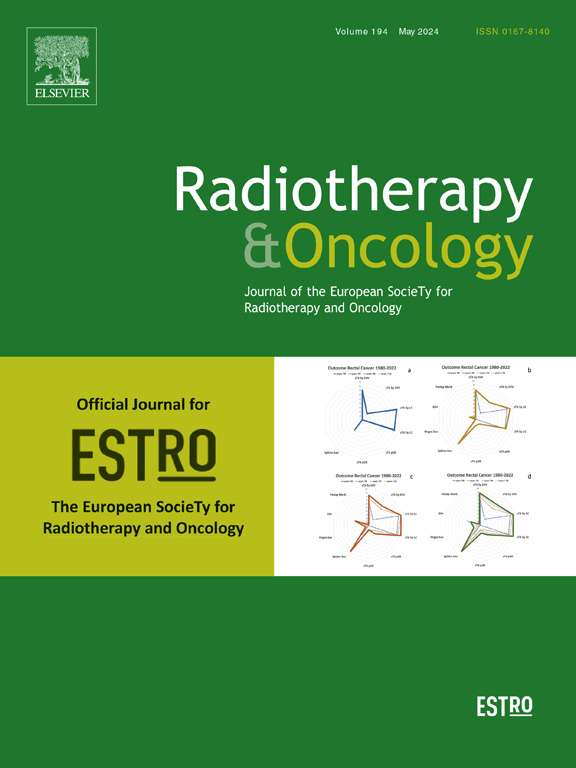通过远程培训提高全球中低收入辐射物理学家的IMRT/VMAT能力。
IF 4.9
1区 医学
Q1 ONCOLOGY
引用次数: 0
摘要
背景和目的:高质量的调强放射治疗(IMRT)/体积调制弧线治疗(VMAT)对于推动积极的患者预后是必要的,但工作人员培训方面的差距阻碍了其在中低收入国家(LMICs)的实施。这项工作旨在评估中低收入国家现有IMRT基础设施的医学物理学家和临床医生的大规模远程培训课程。材料和方法:进行了为期15周的免费虚拟课程,每周现场授课,由专家志愿者领导,结合教学和基于案例的学习。前500名注册者被纳入该计划。通过课前和课后调查,在7个IMRT/VMAT领域采用1-5李克特量表和11个选择题来评估参与者的信心和知识。参与者还为标准化的双侧头颈癌病例制定了治疗计划,由8名专家志愿者使用ProKnow DS平台上的定性标准和定量记分卡进行评估。使用Wilcoxon符号秩检验比较性能。结果:共有240名医学物理学家、医学物理住院医师和剂量师参与了课前和课后调查。平均信心得分从3.00/5 (SD: 1.04)增加到3.80/5 (0.87)(p )。结论:虚拟IMRT/VMAT课程显著提高了参与者的知识、信心和治疗计划技能,证明了一种可扩展的、低成本的干预措施可以改善低收入国家IMRT/VMAT的实施。本文章由计算机程序翻译,如有差异,请以英文原文为准。
Enhancing IMRT/VMAT Competencies in LMICs globally within radiation physicists through remote training
Background and Purpose
High-quality intensity-modulated radiation therapy (IMRT)/volumetric modulated arc therapy (VMAT) is necessary to drive positive patient outcomes, yet gaps in staff training hinder its implementation in low-to-middle-income countries (LMICs). This work aimed to evaluate a large-scale remote training curriculum for medical physicists and clinicians with existing IMRT infrastructure in LMICs.
Materials and Methods
A 15-week free, virtual course with weekly live sessions incorporating didactics and case-based learning led by expert volunteers was conducted. The first 500 registrants were accepted into the program. Participants’ confidence and knowledge was evaluated via pre- and post-course surveys on a 1–5 Likert scale across seven IMRT/VMAT domains and through 11 multiple-choice questions. Participants also created treatment plans for standardized bilateral head-and-neck cancer cases, assessed by eight expert volunteers using qualitative rubrics and quantitative scorecards on the ProKnow DS platform. Performances were compared using Wilcoxon signed-rank tests.
Results
A total of 240 medical physicists, medical physics residents, and dosimetrists responded to both the pre- and post-course surveys. Mean confidence scores increased from 3.00/5 (SD: 1.04) to 3.80/5 (0.87) (p < 0.001). Knowledge scores improved from 4.16/11 (SD: 1.77) to 5.98/11 (SD: 2.11) (p < 0.001). Additionally, 33 participants completed both the pre-course and post-course treatment planning assignments. Automated scorecard performance significantly improved from 12.64/25 (SD: 7.50) to 17.74/25 (SD: 6.74) (p = 0.0004). Grading rubric scores did not significantly change, from 9.15/14 (SD: 3.33) to 9.76/14 (SD: 2.65) (p = 0.4).
Conclusion
The virtual IMRT/VMAT curriculum significantly enhanced knowledge, confidence, and treatment planning skills among participants, demonstrating a scalable, low-cost intervention for improving IMRT/VMAT implementation in LMICs.
求助全文
通过发布文献求助,成功后即可免费获取论文全文。
去求助
来源期刊

Radiotherapy and Oncology
医学-核医学
CiteScore
10.30
自引率
10.50%
发文量
2445
审稿时长
45 days
期刊介绍:
Radiotherapy and Oncology publishes papers describing original research as well as review articles. It covers areas of interest relating to radiation oncology. This includes: clinical radiotherapy, combined modality treatment, translational studies, epidemiological outcomes, imaging, dosimetry, and radiation therapy planning, experimental work in radiobiology, chemobiology, hyperthermia and tumour biology, as well as data science in radiation oncology and physics aspects relevant to oncology.Papers on more general aspects of interest to the radiation oncologist including chemotherapy, surgery and immunology are also published.
 求助内容:
求助内容: 应助结果提醒方式:
应助结果提醒方式:


